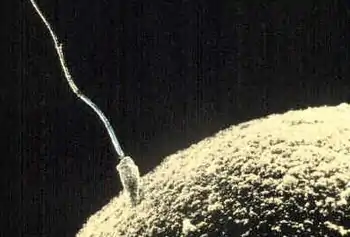Oogamy
Oogamy is the familiar form of sexual reproduction. It is a form of anisogamy (heterogamy) in which the female gamete (e.g. egg cell) is significantly larger than the male gamete and is non-motile. The male gametes are typically highly motile and are usually tasked with all of the travel necessary to bring the respective gametes together. The prevalence of oogamy in higher animals leads to the conclusion that this specialization of the gametes results in their performing their respective tasks better and more efficiently than those tasks could be performed by generalist isogametes, particularly the ability to concentrate high-energy substances in a smaller number of ova.

Evolutionary oogamy
Oogamy is seen to be the evolutionary step that led to internal fertilization, in response to selective pressures at work to inspire this adaptation. This has been most attributed to the independence of animals from liquid water as a means of fertilization among terrestrial species, however other differentiations at the microscale could have also contributed to the change between oogamy and internal fertilization.
One explanation has been the cytoplasmic differences between two gametes, however Randerson & Hurst debunked this theory as unsupported (2001).[1] Most alternative explanations that followed focused on selection based on size, behavioral interactions between gamete cells, and the allocation of resources ecologically.
For the selection of gamete size necessary to catalyze the transition from isogamy to oogamy, the fitness of an organism would have to increase as egg size increases, and increase as sperm size decreases. The number of gametes within the organism alone would exist as a type of selective pressure that promotes smaller sperm size, but disproportionately selects for less eggs as they grow larger within the organism. This supported Bell's theory (1997) that the selective pressure had to select for growth of egg size more than shrinkage of sperm. The standard assumption remains that the zygote fitness is exponentially increased with zygote volume, with zygote numbers declining.
Most recently, Dusenbery (2000) proposed a physical model under the assumption that eggs produce a sperm attractant via pheromones. This provided a mechanism of selection that dramatically increased target size, allowing for a powerful selective force that would produce larger eggs. Assuming the resources available to produce pheromone were proportional to egg volume, the target area was determined as the radius of diffusion of the pheromone's active space, proportional to the rate of pheromone production, and this radius squared would be the target size. The results determined by Dusenbery suggested that this selection process would still occur if the assumption was lessened to only include pheromone production as proportional to egg surface area.
Oogamy predominantly occurs in animals, but can also be found in many protists, certain orders of algae (Ochrophytes, Charophyceans), and some plants such as bryophytes, ferns, and some gymnosperms like cycads and ginkgo.
In some algae, most gymnosperms and all angiosperms, a variation of oogamy occurs where the sperm cells are non-motile as well.
It appears that isogamy was the first stage of sexual reproduction. In several lineages, this form of reproduction independently evolved to anisogamy with gametes of male and female types to oogamy. There is a good argument that this pattern was driven by the physical constraints on the mechanisms by which two gametes get together as required for sexual reproduction.[2]
Oogamy in Diatoms
Since the discussion of the transition of oogamy generally involves the size proportions of certain sex cells, the ability to reproduce this way is closely associated to cell size of the organism themselves. The process of reproduction is the most prevalent method of restoring cell size and is often triggered when the size of the cell is less than critical level; however, this process differs between centric and pennate diatoms.
Centric diatoms are oogamous. The male gametangial cell undergoes a series of four divisions to form a limited number of microspores, which are defined as sperm mother cells. These microspores undergo meiosis to form a flagellated sperm. The oogonial female cells can produce one to two eggs; this female protoplast can facilitate fertilization of the sperm via several different mechanisms, depending on the species. Fertilization results in a zygote, as characteristic in oogamy, which will enlarge into an auxospore after taking up water. It will be spherical in shape with a different valve morphology.
References
- Randerson, J P. and L D. Hurst. "The uncertain evolution of the sexes." Trends Ecol. Evol. 16. n.p.: n.p., n.d.. 28 Mar. 2018.
- Dusenbery, David B. (2009). Living at Micro Scale, Chapter 20. Harvard University Press, Cambridge, Massachusetts ISBN 978-0-674-03116-6.
Further references
- Dunesbery, David B. Ecological Models Explaining the Success of Distinctive Sperm and Eggs (Oogamy). 13 December 2001. pdf. 3 June 2002.
- Halvorson, H. O. & Monroy, A. (1985). The Origin and Evolution of Sex. New York: Alan R. Liss
- “Diatom Reproduction.” Diatom Reproduction, DePaul University, condor.depaul.edu/diatom/sex2.html.
